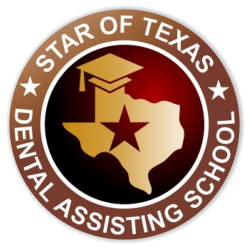Star of Texas Dental Assisting School is a North Austin dental assistant school conveniently located for students living in North, South and Central Austin along with surrounding areas including Cedar Park, Round Rock, Georgetown, Leander, Hutto and Taylor.
Our dental assistant school is a hands-on training program held in an established specialty dental office. This gives students the opportunity to explore multiple dentistry departments.
Dental Assistants are needed in all areas of dentistry, including Orthodontics. Here’s a look at orthodontic treatments.
Fixed and Removable Orthodontics
The traditional and stereotypical movie, television, and commercial vision of orthodontic treatment is one of yards of metal wire tied down to teeth so covered with silver bands and brackets that the whites of the teeth are barely visible. With today’s advanced dental technology, this picture is far from accurate.
Changes in tooth alignment can be accomplished in several different ways. When appropriate, upper and lower arch expanders can be used to increase the curvature of the tooth-bearing supporting structures. These expanders are usually cemented into place and are not able to be removed by the patient. The expanders are often a prelude to fixed metal bands. They can be cemented to the teeth as well as longitudinal arch wires and springs and still be used to move teeth.
Some time ago, the desire of patients to show less metal resulted in the development of bonded tooth-colored and clear brackets (as opposed to the metal bands that completely surround a tooth). These brackets cover only about 25% of the tooth surface and are bonded into place. The trade-off with the more esthetic bonded brackets is a higher percentage of dislodgement of the bracket, requiring additional office visits for repair and replacement. The wires and springs are changed periodically to accomplish the various stages of movement. The metal components stay in place until the tooth movement is finished. Some dental conditions mandate the use of this traditional orthodontic process.Removable:
It is not always necessary to use fixed devices to move teeth. Less aggressive tooth movement can additionally be done with patient-removable appliances. Some are made of a gum-colored pink acrylic material with metal wires and springs embedded in them. These are worn by the patient except when he or she is eating, brushing, and flossing. The metal and plastic appliances do not show as much metal so they are somewhat more acceptable. The trade-off with removable appliances is that they only work when they are in the patient’s mouth, making proper patient compliance a big issue. If you do not wear them, the teeth will not move as planned. The metal and plastic appliances are used in what is called minor tooth movement. Many orthodontic cases are not appropriate for removable appliance therapy.
Invisalign:
Several years ago, a new type of removable appliance therapy was developed and patented. Align Technology has a product called Invisalign. Clear, thin plastic aligners (positioners) are sequentially placed to move the teeth in a precise fashion. The aligners are left in the mouth as much as possible and removed only for eating, drinking, and cleaning the teeth. Again, if you do not wear them, the teeth will not move. The aligners are almost invisible when in place and are extraordinarily acceptable esthetically. They are indicated for adults and patients older than 14 years who have all permanent teeth in including fully erupted second molars. They can be used to treat simple to fairly extensive misalignment problems. Most cases are completed in about 12 months. Research is still in progress to determine the limits of this process.
The doctor who will be performing the orthodontic treatment will take these different modalities into consideration and develop a treatment plan best suited to your needs. Age of the patient, number of teeth involved, and extent of movement are primary factors in the decision-making process. Please be sure to ask why or why not one technique rather than another was suggested.

